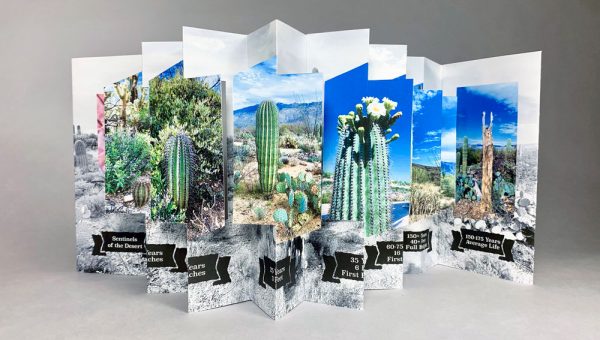
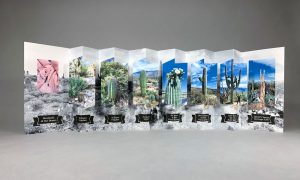 Saguaro cactus, majestic symbol of the Sonoran Desert, are endangered by climate change, drought and competing invasive plant species. Their only native habitat is this arid, mountainous desert and they form the foundation of an interdependent ecosystem that would be forever lost if conditions continue to decline.
Saguaro cactus, majestic symbol of the Sonoran Desert, are endangered by climate change, drought and competing invasive plant species. Their only native habitat is this arid, mountainous desert and they form the foundation of an interdependent ecosystem that would be forever lost if conditions continue to decline.
To the Tohono O’odham, who have lived in the Sonoran Desert for thousands of years, the Saguaro is an integral part of their culture, regarded with the same respect given to people. The importance of the cactus’ sweet red fruit is reflected in the O’odham calendar, and provides the ceremonial wine used to herald in summer monsoon rains.
This limited-edition artist book uses Hedi Kyle’s Panorama structure presenting two stories of these beloved desert icons. This structure was chosen as a way to present a dynamic visual timeline and as an exploration of the usage of text on what is often a blank back side.
The first side is a visual timeline of the life of the Saguaro, which has an average life span of 150-175 years and can grow as high as a four-story building. Original photos captured at the Saguaro National Park in Tucson, Arizona document the cactus from delicate seeds scattered by coyote scat, to monumental maturity, and then decay and death leaving behind a ribbed wooden skeleton.
The second side features a poem written by the artist, celebrating the majesty and cultural touchstone that is this vital species and worrying over the most serious threats to the Saguaro, and indeed, the desert’s survival.
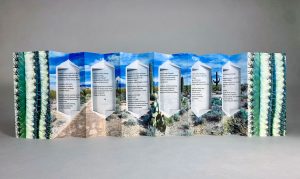 Click on images for larger views.
Click on images for larger views.
Sentinels of the Desert
Limited Edition Artist Book
$350
To purchase this book contact Laura.
Or, click here to purchase online at 23 Sandy.
Limited edition artist book. Hedi Kyle’s Panorama book structure. Archival pigment prints on Mohawk Superfine paper. Six panels plus covers. 4 x 8 x .375 inches closed. Accordion extends out to 32 inches. Presented with a matching cover wrapper with title and colophon plus a bristol board protective phase wrapper. Signed and numbered edition of 25. © 2020.
The poem reads:
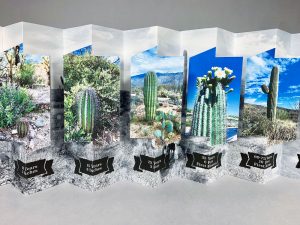 Saguaro cactus, majestic symbol,
Saguaro cactus, majestic symbol,
iconic wonder of the wild west.
Sentient beings, so human-like.
Individual, mortal, somatic, fleshly.
Sentinels of the desert
so beloved, so integral.
Arms raised in triumph,
a symbol of hope.
To the Tohono O’odham people:
legend and lifeline.
A boy in the sand
becomes a saguaro.
Sweet red fruit becomes wine
marking a new calendar,
calling for the thundering monsoon season.
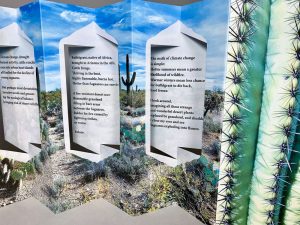 Keystone species, essential as water,
Keystone species, essential as water,
foundation of the Sonoran Desert.
Census-counted, like humans
every decade,
citizen scientists scouring,
scouting young pricks
to elder statesman.
Marvels of water storage,
volume and vastness
ribs doubling in diameter
after a brief spell
of creosote-scented rain.
Roots spread wide and shallow
under the surface of the sand
capturing droplets before they
exhale, evaporate,
dissipate, dessicate.
June’s dry heat sizzles and pops.
Bighorn Fire ravages Pima Canyon,
flames shooting down the
mountain slopes
and up the sides of Saguaro bodies.
Early estimates: 2000 lost forever.
Lost: a cardinal ecosystem.
Lost: a delicate balance so vital.
Saguaros seem tough,
thick skinned.
But they’re fragile,
relying on summer monsoons
and winter rains that prevail here.
Arid Arizona, northern Mexico
their only native habitat.
Climate change, drought
human activity, cattle ranching,
concrete urban heat islands
all faulted for the decline of
young saguaros.
But perhaps most devastating,
invasive weeds and grasses
tip the ecological balance,
bringing risk of desert wildfires.
Buffelgrass, native of Africa,
brought to Arizona in the 40’s.
Cattle forage.
Thriving in the heat,
highly flammable, burns hot.
Hotter than Saguaros can survive.
A fire-resistant desert now
flammable grassland
filling in bare areas
between the Saguaros,
fodder for fire caused by
lightning strikes,
or worse.
The math of climate change
is simple:
Hotter summers mean a greater
likelihood of wildfire.
Warmer winters mean less chance
for buffelgrass to die back,
hard freeze.
I look around,
imagining all these strange
and wonderful desert plants
replaced by grassland, and shudder.
I close my eyes and see
Saguaros exploding into flames.



Comments (0)